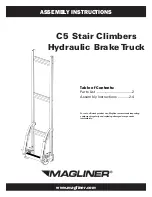
Maintenance Instructions
pressures should be checked daily and always before
long-distance trips.
Follow the tire manufacturer’s recommended cold inflation
pressure for the tire size, type, load range (ply rating), and axle
loading typical for your operation. (Each steer axle tire load will
equal 1/2 steer axle loading; each drive tire load will be 1/4 the
axle loading, if fitted with four tires.)
Checking Inflation
Always check inflation pressure when tires are cold. Never bleed
air from hot tires to relieve normal pressure buildup. Normal
increases in pressure during operation will be 10 to 15 psi (69
to 103 kPa), which is allowable in truck tires. Tires on the same
axle should have the same air pressure as the corresponding
other tire(s) on that axle. Steer tires should be within a 3 psi (21
kPa) pressure range. All drive tires should be within a 5 psi (34
kPa) pressure range. Tag or pusher axle tires on the same axle
should be within a 5 psi (34 kPa) pressure range.
To minimize rim corrosion, it is particularly important to keep
moisture from the inside of tires and proper selection of air
compressor equipment, proper air line routing, and the use of
shop air dryers is strongly recommended to avoid moisture in
the high-pressure air used for tire inflation.
Underinflation
Tires should not be allowed to become underinflated. Increased
flexing due to underinflation causes heat buildup within the
tire components. This leads to reduced strength, breakdown
of the rubber compounds and possible separation of the
tire components (i.e., ply and tread separation and reduced
retreadability).
Underinflation is also the primary cause of blowouts. In addition,
low inflation causes an increase in rolling resistance. This results
in reduced fuel mileage, a loss in tread life, and uneven wear
due to increased tread movement. To determine proper inflation,
refer to the tire inflation range stated on the tire sidewall and the
tire manufacturer’s tire load-pressure charts.
Inspection
Check condition of tires for abnormal wear patterns and proper
inflation pressures. Cut or broken tire casings must be repaired
or replaced.
Tires should be inspected for the following conditions. If any are
present, the tire should be removed and repaired, retreaded, or
scrapped as the condition indicates.
•
Any blister, bump, or raised portion anywhere on the surface
of the tire tread or sidewall (other than a bump made by a
repair). These indicate the start of internal separation.
•
Any cut that reaches to the belt or ply cords or any cut that
is large enough to grow in size and depth.
•
Any nail or puncturing object.
•
If any stone or object is held by a tread groove and is starting
to drill into the tread base, remove the object.
Proper tire inflation, toe-in adjustment,
loads, and road
speeds are important factors governing tire life, steering
ease, maneuverability, fuel economy, and ride quality.
196
3879634R1
Содержание WorkStar Series
Страница 4: ...Operator s Manual WorkStar Series Printed in the United States of America 3879634R1...
Страница 12: ...Table of Contents viii 3879634R1...
Страница 48: ...Inspection Guide 36 3879634R1...
Страница 52: ...Controls Features 40 3879634R1...
Страница 65: ...Controls Features Declination Zone Map 3879634R1 53...
Страница 100: ...Controls Features 88 3879634R1...
Страница 214: ...Maintenance Instructions 202 3879634R1...
Страница 238: ...Maintenance Intervals And Specifications 226 3879634R1...
Страница 258: ...Index 246 3879634R1...

































